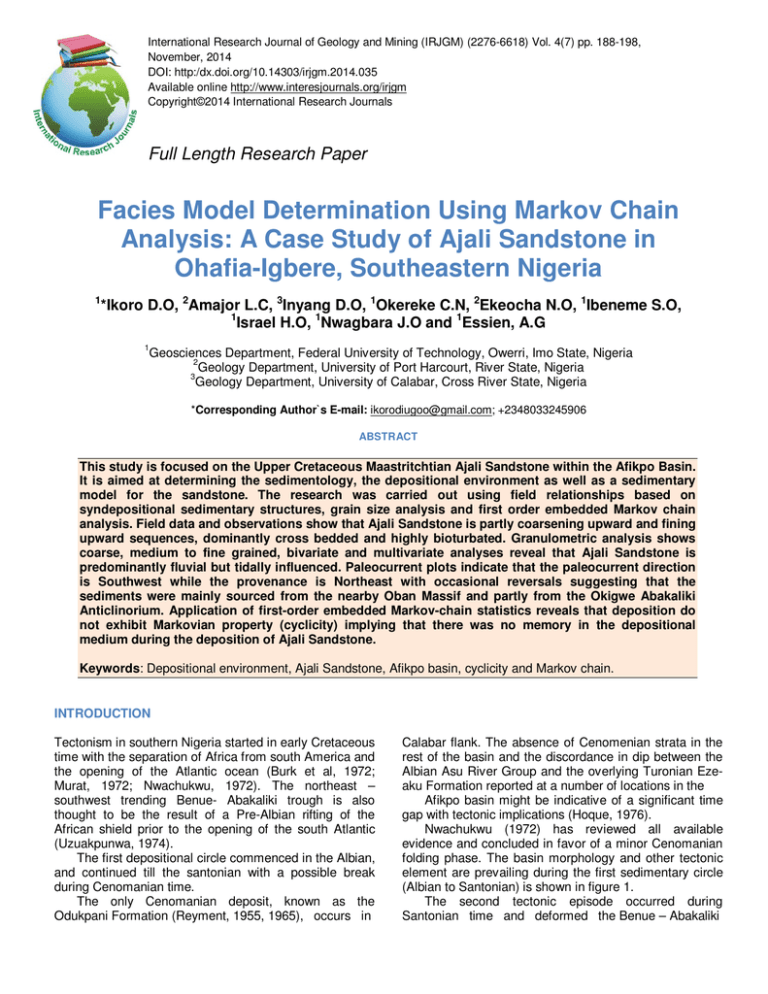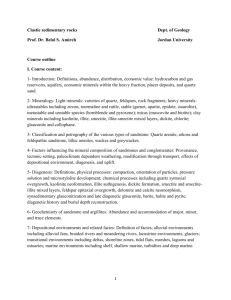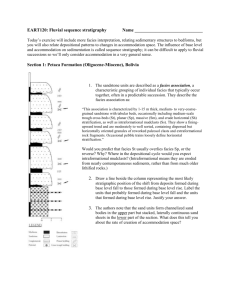Document 14104601
advertisement

International Research Journal of Geology and Mining (IRJGM) (2276-6618) Vol. 4(7) pp. 188-198, November, 2014 DOI: http:/dx.doi.org/10.14303/irjgm.2014.035 Available online http://www.interesjournals.org/irjgm Copyright©2014 International Research Journals Full Length Research Paper Facies Model Determination Using Markov Chain Analysis: A Case Study of Ajali Sandstone in Ohafia-Igbere, Southeastern Nigeria 1 *Ikoro D.O, 2Amajor L.C, 3Inyang D.O, 1Okereke C.N, 2Ekeocha N.O, 1Ibeneme S.O, 1 Israel H.O, 1Nwagbara J.O and 1Essien, A.G 1 Geosciences Department, Federal University of Technology, Owerri, Imo State, Nigeria 2 Geology Department, University of Port Harcourt, River State, Nigeria 3 Geology Department, University of Calabar, Cross River State, Nigeria *Corresponding Author`s E-mail: ikorodiugoo@gmail.com; +2348033245906 ABSTRACT This study is focused on the Upper Cretaceous Maastritchtian Ajali Sandstone within the Afikpo Basin. It is aimed at determining the sedimentology, the depositional environment as well as a sedimentary model for the sandstone. The research was carried out using field relationships based on syndepositional sedimentary structures, grain size analysis and first order embedded Markov chain analysis. Field data and observations show that Ajali Sandstone is partly coarsening upward and fining upward sequences, dominantly cross bedded and highly bioturbated. Granulometric analysis shows coarse, medium to fine grained, bivariate and multivariate analyses reveal that Ajali Sandstone is predominantly fluvial but tidally influenced. Paleocurrent plots indicate that the paleocurrent direction is Southwest while the provenance is Northeast with occasional reversals suggesting that the sediments were mainly sourced from the nearby Oban Massif and partly from the Okigwe Abakaliki Anticlinorium. Application of first-order embedded Markov-chain statistics reveals that deposition do not exhibit Markovian property (cyclicity) implying that there was no memory in the depositional medium during the deposition of Ajali Sandstone. Keywords: Depositional environment, Ajali Sandstone, Afikpo basin, cyclicity and Markov chain. INTRODUCTION Tectonism in southern Nigeria started in early Cretaceous time with the separation of Africa from south America and the opening of the Atlantic ocean (Burk et al, 1972; Murat, 1972; Nwachukwu, 1972). The northeast – southwest trending Benue- Abakaliki trough is also thought to be the result of a Pre-Albian rifting of the African shield prior to the opening of the south Atlantic (Uzuakpunwa, 1974). The first depositional circle commenced in the Albian, and continued till the santonian with a possible break during Cenomanian time. The only Cenomanian deposit, known as the Odukpani Formation (Reyment, 1955, 1965), occurs in Calabar flank. The absence of Cenomenian strata in the rest of the basin and the discordance in dip between the Albian Asu River Group and the overlying Turonian Ezeaku Formation reported at a number of locations in the Afikpo basin might be indicative of a significant time gap with tectonic implications (Hoque, 1976). Nwachukwu (1972) has reviewed all available evidence and concluded in favor of a minor Cenomanian folding phase. The basin morphology and other tectonic element are prevailing during the first sedimentary circle (Albian to Santonian) is shown in figure 1. The second tectonic episode occurred during Santonian time and deformed the Benue – Abakaliki Ikoro et al. 189 Ba si n F la n k Enugu Benin Onitsha R DE LT A x x x x x k ali ak Ab Abakaliki po e fi k in A ncl y S x x x r Fl an k x x x M Em a mte b ay me nt x x x x x 6 x x x x x x x OBAN MASSIF x x x x x x x x x x x x x x x x x x x x x x x x in as iB Ca lab a x x x X x x x x m br a x x 8 CAM E RO UN ME NT CO MP LE M PL EX CO EN T SE M x R e nu Be BAS E CAM ERO U MEN N T C OM P LEX s in Ba e nu Be Lokoja x x x x x NI GE x x x x x x x x x x x x x x x 6 KEY MAPS x x B ASE x x x 8 x x x x x x x x x x x Nigeria Africa x x x x x x x x x x x x x x x x x x x x 8E x x x 0 6 x x x x An a I - BE NU x x x BA S E FO LD in Bas x x x B e ni n x x x ra ABAK x x x x x x amb A L IK x x x x x x x x x x x x An x x IG ER DE LT A 8E x x N x x x x x x x x x x x x ED B E LT x x x x x x NT ME X SE PLE A B OM C x x x x x x x Em Nig ba e r ym ent x x x x x x x x x x x r t ge en Ni aym b Em x x 100km SCALE Figure1. Configuration of Anambra and Afikpo basins (second sedimentary circle) trough into folding belts. This structural inversion was accomplished by the formation of a wider Anambra basin on the western flank and the smaller Afikpo basin on southeastern flank of the anticlinorium (figure 2). The Santonian uplift resulted in the Abakaliki folded belt (Burke et al., 1972: 198). Much of the eroded material was deposited in the Anambra basin which became the major depocenter during Campanian to early Eocene times. The third sedimentary circle commenced with the southward growth of the present Niger delta, perhaps, in late Eocene and Early Oligocene times (Hoque, 1975). In Anambra and Afipko Basins, the strongly folded AlbianConiacian succession (Pre-Santonian sediments) is overlain by nearly flat-lying Campanian-Eocene succession. The oldest sediment in the Anambra Basin is Nkporo Group (Nwajide, 1990). It was deposited into the basin in Late Campanian, comprising Nkporo Shale, Owelli Sandstone and Enugu Shale (Reyment,1965 and Obi, 2001). Nkporo Group is overlain by the Early Maastrichtian Mamu Formation (Kogbe, 1989 and Obi, 2000). It comprises succession of siltstone, shale, coal seam and sandstone (Kogbe, 1989). Ajali Sandstone (Maastrichtian) overlies Mamu Formation (Reyment, 1965; Nwajide, 1990) which is mainly unconsolidated coarse-fine grained, friable or poorly cemented; mudstone and siltstone (Kogbe, 1989). Ajali Sandstone is overlain by diachronous Nsukka Formation (Maastrichtian-Danian) which is also known as the Upper Coal Measure (Reyment, 1965 and Obi, 2000). Imo 0 100 KM SCALE Figure2. The generalized map of sedimentary Basins in southern Nigeria. Murat (1972). The Cretaceous basin is stippled. Shale (Paleocene) overlies Nsukka Formation (Nwajide, 1990). Comprising of clayey- shale with occasional ironstone and thin sandstone in which carbonized plants remains may occur (Kogbe, 1989). The Eocene stage was characterized by regressive phase that led to deposition of Ameki Group (Obi, 2000) Table 1 below. Location The study area covers the Upper Cretaceous sediments of the Afikpo basin, precisely the Maastritchtian Ajali Sandstone exposures at Ohafia - Abiriba - Igbere area southeastern Nigeria. The area lies within longitudes 007o 37I 26.3II E and 0070 50I METHODOLOGY A total of 14 samples were collected from five different locations in the study area. Each litho-unit was carefully studied in detail and field observations properly documented. The various representative samples were carefully dried and desegregated. There were no fixed weights of sample used.. The sieving process was achieved in accordance with the recommendation of Folk (1974) and Pettijohn (1975). The samples were weighed using triple beam balance. Each of the weighed samples was shaken for 15 minutes by the mechanical sieve shaker. The weight of sample retained in each sieve mesh was determined, recorded and used to calculate individual weight percent retained and cumulative weight 190 Int. Res. J. Geo. Min. Table 1. Correlation Chart for Early Cretaceous Tertiary Strata in the Southeastern Nigeria (After Nwajide 1990) Age M.Y 30 Oligocene 54.9 Eocene 65 Paleocene 73 Maastritchtian 83 Campanian 87.3 Santonian Abakaliki-Anambra Basin Ogwashi-Asaba formation Ameki/Nanka formation/Nsugbe Sandstone (Ameki Group) Imo Formation Nsukka Formation Ajali Formation Mamu formation Nkporo/Oweli formation/Enugu Shale Afikpo Basin Ogwashi-Asaba formation Ameki Formation Imo Formation Nsukka Formation Ajali Formation Mamu formation Nkporo Shale/Afikpo Sandstone Non deposition/Erosion Agbani Sandstone/Agwu shale Coniancian 88.5 Turonian Cenomanian Albian 93 100 Eze Aku Group (ind. Amasiri Sandstone) Eze Aku Group Asu River Group Asu River Group 7 36 E 7 47 E 5 44 N 7 O k o k o I te m 5 44 N 6 7 Igbere A b ir i b a 6 N O h a f ia 7 7 8 A m a n ta 7 8 8 7 A fia U s u 10 10 O go-U bio 10 5 39 N 8 5 39 N 7 47 N 7 36 E LE G E N D 0 2 km S CA LE 10 I m o S ha le G ro u p 8 6 N s u k k a F o r m a t io n R ive r 7 A j a li S a n d s t o n e G e o lo g i c a l B o u n d a r y M a m u F o r m a tio n O u t c ro p L o c a t io n S TRIKS W ITH D IP 1 3 E 14 N 15 E N IG E R IA 29 4 N S t u d y A re a Figure3. Location and Geologic map of the study area 27.1IIE and latitudes 050 43I 12.6IIN and 050 44I 10.8IIN percent after the necessary correction was done to account for the weight lost while sieving. The histograms and accumulative curves were plotted from the sieve results. Also the univariate, bivariate and multivariate parameters were computed from the sieve result after Folk and Ward (1970), multivariate analysis after Sahu (1964) and the bivariate plots after Friedman (1967) and Sly (1978). From the field observations, various litho-log were built and subjected to Markov chain analysis according to John (2002). RESULTS FACIES ANALYSIS AND DESCRIPTION Planar cross bedded sandstone facies A This particular facies is found in all the locations studied. Its colours ranges from white to grey with patches of yellow to red colorations. It is medium to coarse grained, low to medium angled, poorly to moderately sort with Ikoro et al. 191 Figure 4. Planar cross bedded sandstone facies A exposed at Ohafia. Figure 6. Horinzontal outcropping in Abiriba. bedded Figure8. Massive Sandstone facies Sandstone Figure 5. Bioturbated sandstone facies with Skolithos burrows exposed in Abiriba. facies Figure7. Cross laminated Sandstone facies exposed at Igbere. Figure9. Herringbone cross bedded sandstone facies exposed Abiriba 192 Int. Res. J. Geo. Min. Fig10. L1S1 Fig14. L3 Fig12. L2S1 Fig11. L1S2 Fig15. L4 gradational contacts but sharp contacts when underlain or overlain by mudstone facies.The average thickness of this facies in this study is 3.8m. This facies is often overlain by the bioturbated sandstone facies or the horizontal bedded sandstone facies in Ohafia and Abiriba exposures fig 4. Clay drapes were observed lining the bedding planes. Bioturbated Sandstone facies B This facies is whitish-grey in colour with clear imprints of trace fossils burrows belonging to Skolithos genera. It is fine to medium grained with an average thickness of 1. 45meters. this facies best outcrops at Abiriba where thickness measures about 3.2meters. This facies is shown in Fig.5. In Abiriba and Igbere the facies is overlain by an alternating layer of sandstone and Fig13. L2S2 Fig16. L5 mudstone (heterolithic bedded facies) averaging 0.6meters thick. In Ohafia bioturbated sandstone is overlain by the horizontal bedded sandstone. Horizontal bedded Sandstone facies C This facies consist of beds of fine grained sandstone alternating with siltstone . The sands are well graded and fairly well sorted. The maximum thickness of this facies measured about 3.16 metres in Abiriba outcrop. In Ohafia and Igbere thickness averages 1.73meters. This facies is shown in figure 6. Cross laminated Sandstone D This facies is whitish brown, fine to medium grained, cross laminated sandstone with clear imprints of a Ikoro et al. 193 liesengang structure. It is moderately sorted and has an average thickness of 1.8 meters fig 7. Massive Sandstone facies This facies is white to grey in colour, fine to medium grained, moderately to poorly sorted Sandstone. Its structureless nature may be as a result of it being deposited by extremely high energy current or its structure may have been destroyed by massive bioturbation. It has an average thickness of 4-5meters Fig.8. the fixed probability vector cannot be used to estimate the columns of the expected transition probability matrix because a transition from a state to itself is not allowed in embedded Markov chain. In order to estimate the frequencies of transition from each state to itself, we do this by assigning some arbitrarily large number say 100, to the diagonal positions of the observed transition frequency matrix. TO FRM Herringbone Cross Bedded Sandstone Facies This facies is whitish yellow in colour, medium grained planar cross bedded sandstone dipping at an average angle of 12 to 15 degrees to the bone. Poorly to fairly well sorted with sharp contacts. It has an average thickness of 4 meters Fig. 9. Lithologic profiles errected in the field are shown in figures 10-16. The mutually exclusive states are planar cross bedded sandstone (A), hetrolithic/lenticular bedded sandstone (B), horizontal laminated sandstone (C), mudstone (D), cross laminated sandstone (E), trough cross bedded sandstone (F), planar cross bedded with a herringbone structure (G), massive bedded sandstone (H) and convoluted sandstone (I) Each and every one of the litho-logs above is subjected to embedded Markov chain analysis. From Fig.10 above, the observed transitional matrix is A B C D A 100 1 0 0 101 B 2 100 0 0 102 C 0 0 100 1 101 D 0 1 0 100 101 102 102 100 101 405 GT CLM TL ROW TL First trial (step1) Dividing row totals by grand total, TO A A FRM B C D ROW TOTALS 0.249 B 0.249 0.252 C 0.252 0.249 D 0.249 0.249 Squaring the probability along the multiplying by the grand total of 405. 0.249 diagonal and TO From A B C D ROW TOTALS(R.TL) A 0 1 0 0 1 B 2 0 0 0 2 C 0 0 0 1 D 0 1 COLUMN TOTALS(C.T) 2 2 0 B C D ROW TL A 25.11 1 0 0 26.11 B 2 25.72 0 0 27.72 1 C 0 0 25.11 1 26.11 0 1 D 0 1 0 25.11 26.11 1 5 GRAND TOTAL (G.T) 27.11 27.72 25.11 26.11 106.05GT Dividing Row totals by grand total, the observed fixed probability vector will be: A B C D A 0.200 0.400 0.200 0.200 Once the transitional matrix is built, a CHI-Test can be carried out to check for the Markov property in an embedded sequence which is done by comparing the observed transition frequency matrix to the expected matrix if successive states are independent. However, FRM C TL These new estimates are inserted into the original transition frequency matrix and the process repeated again and again until the estimated transition frequency along the diagonal do not change from time to time. It is observed that after the seventh trial that the transition probability matrix does not change. Thus, the expected fixed probability vectors can be obtained. A B C D 0.160 0.519 0.160 0.160 The expected probabilities and the expected frequencies of a hypothetical sequence of independent states can be 194 Int. Res. J. Geo. Min. Table2. Values and critical values of the lithostratigraphic succession of locations within the study area for 5 degree of freedom and at 5% level of significance Locations L1S2 L2S1 L2S2 L3 L4 L5 Remarks Critical value of 5.280 3.696 8.960 5.280 2.689 5.280 11.07 19.68 30.14 11.07 11.07 11.07 Independent Independent Independent Independent Independent Independent Table3. Multivariate results S/N 1 2 3 4 5 6 7 8 9 10 11 12 13 14 SAMPLE CODE L1S1U1 L1S1U2 L1S2U2 L2S1U1 L2S1U2 L2S2U1 L2S2U2 L3S1U1 L3S1U2 L3S1U3 L3S1U4 L3S1U5 L4S1U3 L5S1U1 RESULT -8.619 -6.327 -7.736 -9.002 -8.217 -2.514 -7.369 -5.327 -4.992 -1.583 -1.869 -6.213 -7.175 -9.042 calculated from the fixed probability vectors thus, if state A is independent of state B, then P(A/B)=P(A)P(B). Where P(A) and P(B) are given in the fixed probability vector as well as other states. For example, P(A/B)= (0.160)(0.519)= 0.083. The expected probabilities of all transitions are given thus: TO FROM A B C D A 0.026 0.083 0.026 0.026 B 0.083 0.269 0.083 0.083 C 0.026 0.083 0.165 0.026 D 0.026 0.083 0.026 0.026 The expected frequencies are found by multiplying this matrix above by the grand total of 7.498, TO FROM A B C D A 0.195 0.622 0.195 0.195 B 0.622 2.017 0.622 0.622 C 0.195 0.622 0.195 0.195 D 0.195 0.622 0.195 0.195 REMARKS Fluvial Shallow marine Fluvial Fluvial Fluvial Shallow marine Shallow marine Shallow marine Shallow marine Shallow marine Shallow marine Shallow marine Shallow marine Fluvial Using (CHI) Test, =∑ ……………equation (1) Where O is the number of transitions from one state to another and E is the number of transitions expected if the successive states are independent. = + + + + + . =0.0003+3.053+0.230+0.008+0.230+0.0003+ 3.323+0.0003+3.774. =6.844. This test has V= -M degree of freedom, where M is the number of states and in this, V= 6= =9-4=5 degree of freedom. The critical value of for 5 degree of freedom and at 5% level of significance is 11.07 which are far greater than the test Ikoro et al. 195 Fig17. cumulative curves for Samples in location Fig18. Cumulative curves for in location 2 Fig19. Cumulative curves for samples in location 3 Fig20. Cumulative curve for samples in location 4 and 5 196 Int. Res. J. Geo. Min. Fig21. bivariate plot of skewness against standard deviation Fig22. bivariate plot of mean size against standard deviation Fig23. Rose diagram of Ajali Sandstone in the study area statistics. The rest of the litho-log from the various locations were subjected to embedded Markov chain analysis followed by chi-test which gave the following results (table 2 above) The kicks observed in the probability curves show sediments deposited under suspension, saltation and traction mechanisms as shown in Fig.17 to Fig.20 above. The multivariate (Table 3 above) shows that Ajali Sandstone is mainly shallow marine deposit and fluvial in part. The bivariate plots that (Fig. 21 and 22) show both beach and river complimenting the result from multivariate environment discriminant analysis. DISCUSSION From the inherent sedimentary structures and the stratigraphic sequence that have been observed from the field, it is obvious that the fining upward sequence and coarsening upward sequence that dominated the outcrops also suggest an interplay of both continental and marine environments respectively. The Ajali Sandstone litho-logs in all the locations in the study area have a tabular cross-stratification and according to Smith (1970) and Harms et al (1975), tabular sets of crossstratification are deposited by migrating sand waves. Ikoro et al. 197 Sand waves and dunes are common on the beds of a river and tidal channels. Collins et al (1982, pp 73), and Harm et al (1975, pp 49), showed that tabular sets of cross strata with planar configuration is suggestive of fluvial settings. The sieve analysis shows that Ajali Sandstone is coarse, medium to fine grain poorly sorted sandstone, which suggests fluctuation in energy of deposition. The presence of shale beds interactions in some locations is enough evidence to support the line of thought that Ajali Sandstone is from both marine and continental setting that is fluvio-deltaic deposits. Based on granulometric analysis, the histograms show unimodal and probability plots indicate that the Sandstone was deposited by suspension, saltation, traction transport mechanisms, thus, showing that energy of the transporting medium was fluctuating. The sieve analysis also showed that Ajali Sandstone is coarse, medium to fine grained but dominantly medium grained, poorly sorted suggesting fluctuation in energy of deposition though with dominance of high energy . The fine grained indicates deposition from suspension during lower energy conditions; while the cross bedded Sandstone indicate deposition by saltation during higher energy hydrodynamic conditions. These also correspond to the bivariate plots suggested Sly (1978) in which the sediments fall mostly in the high energy zone. The coarsening upward sequence of Ajali Sandstone as indicated by univariate result suggests that the Basin was shallowing upward Dapple, (1974) and Tuker, (1996). This shallowing upward of the Basin at the time of deposition of Ajali Sandstone in the Afikpo basin may be interpreted as a result of fluvial interference with the marine environment and this line of thought is supported by the computed multivariate results. Friedman and Sanders (1978, pp 73) also indicated moderately well sorted and moderately sorted sands as the analysis had shown are mostly found in inland dunes, most rivers, most lagoons and marine shelf environments. Trace fossils have been used to infer depositional environment as pointed out by Horward et al., (1979) and Frey (1977). The outcrops at Abiriba quarry site and most of the other locations are overlain by heavily bioturbated firm ground: Rhyzocorallium and Ophiomorpha. The Rhyzocorallium is horizontal or obliquely oriented, U- shaped burrows. It is interpreted as feeding burrows where the animal moves in horizontal pattern Howard et al., (1972). Ophiomorpha is a branching burrow with horizontal, oblique and vertical box-like network. It is interpreted as a combined dwelling and feeding burrows made by shrimp-like animals. The observed trace fossils are good indicators of environment ranging from marginal marine to shallow marine environments (Frey et al., 1978 and Wilson et al., 1997). The rose diagram (Fig. 23) for Ajali Sandstone suggests that the direction of paleocurrent as at the time of deposition, acted in southwest direction and the provenance was northeast. The rose diagram reflects unimodal high variability paleocurrent pattern for Ajali Sandstone (Fig.23). This paleocurrent pattern (Unimodal) suggests sediments deposited in an environment where fluvial currents was prevalent with net long-shore marine transport (Selly, 1966). The direction of provenance indicated that the sediments of Ajali Sandstone were sourced from the Basement Complex of Nigeria probably Oban Massif and or Cameroun Mountains. A simple graph of the most significant transitions from the observed transitional matrices of all the lithostratigraphic succession built from each of the location in the study area, shows that Ajali Sandstone do not have a repetitive pattern of succession. The embedded Markov chain analysis in this study show that probability of a particular facies being preferentially succeeded by one particular facies does not exist. CONCLUSION Textural result together with field observation of Ajali Sandstone in the study area coupled with the field data have aided in reconstructing the ancient environment of deposition of Ajali sandstone in Afikpo basin. Facies analysis result shows that Ajali Sandstone outcrops in the study area describes sediments deposited in fluvial environment but highly influenced by tidal activities. Tidal signatures present in the area include bioturbated sandstone, herringbone cross bedded sandstone and flaser heterlithic facies.This study proposes a subtidal through intertidal to continental environments. This is similarly interpreted by Amajor (1987), Adeigbe et al., (2007). Field data and facies observations coupled the result of Markov chain anaysis show that the sandstone in Ohafia- Igbere area does not exhibit cyclicity. It does not pocess markovian property which implies that there is no memory in the depositional medium. However, Ajali Sandstone in this study is medium-coarse grained and dominantly fining upward sequence. REFERENCES Adeigbe OC, Salufu AE (2007). Geology and Depositional Environment of Campano – Maastrichtian Sediment in the Anambra Basin, Southeastern Nigeria: Evidencr from Field Relation and Sedimentation Study. Earth Sci. Res. J. 13: 44 – 22. Akaegbobi IM, Boboye OA (1999). Textural, Structural Features and Microfossil Assemblage Relationship as a delineating Criteria for the Stratigraphic Boundary Between Mamu Formation and Nkporo Shale Within the Anambra Basin, Southern Nigeria. J. Afr. Earth Sci. 17: 445-455. Andrew DM (1984). Principles of Sedimentary Basin Analysis Springerveriag, New York, Basin, Heilddbedded, Tokyo. P133 – 202. Amaral EJ, Proyer WA (1977). Depositional Environment of St. Petters sandstone Deduced by texture Analysis. J. Sed. Pet. 40. Amajor LC (1987). Paleocurrent, Petrography and Provenence, Analysis of the Ajali Sandstone (Upper Cretaceous) South Estern Benue Trough Nigeria. Banerjee I (1976). Analysis of Cross Bedded Sequence. An example 198 Int. Res. J. Geo. Min. from the Ajali Sandstone (Maastrichtian) of Nigeria; Quart. JL. Geo. Mining and Material Society, India. 51: 69 – 81. Burke KC, Desauvagie YFY, Whiteman AJ (1972). Geology History of Benue Valley and Ajacent Areas. In Y.F.Y Dessaugie and A.J. Whiteman (Edition), Afr. Geol. Univ. of Ibadan. 187 – 205. Colinson Jd, Thompson DB (1982). Sedimentary Structures. George Allen and Unwin London. Dapple EC (1974). Sandstone Type and their Association Depositional Environments. J. Sed. Petr. 4: 695 – 707. Friedmen GM (1967). Dynamic Process and Statistical Parameters Compared for Size Frequency Distribution of Beach and River sand, J. Sed. Petr. 37: 337 – 354. Friedmen GM, Sanders JE (1978). Principles of Sedimentology. John Wiley and Son, New York. Grant NK (1971). The South Atlantic Benue Trough and Gulf of Guinea Triple Junction Bulletin Geol. Soc. America 82:2293 – 2298. Harms JC, Southard JB, Spearing DR, Walker RG (1975). Stratification Produced by Migrating Bedforms: in Depositional Environment as Interpreted from Primary Sedimentary Structures and Stratification Sequences. SPEM Short Course No.2 Dallas. Ikoro DO (1998). Depostional Environment of Upper Cretaceous (Maastrichtiian) Sediment of Afikpo basin. M.Sc. Petroleum Geology Thesis, Department Of Geology, F.U.T .O. 82 – 125. Iwuagwu, C.J. and Lerbekmo, J.S., (1982). The Petrology of the Basal Belly River Sandstone Reservation, Penidina Field Alberta, Bulletiin of Canadian Petrol Geol. 30(3):187 – 207. John CD ( 2002). Statistics and Data analysis in Geology, John Wiley and Son, New York. 123-178. Krumbein WC (1947), Analysis of Sedimentation and Diagenesis. Bulletin, American Association of Petroleum Geology. 34 :700 – 718. Kogbe CA, Tokarski AD, Wozuy DE (1978). Geology of the Makurdi Sheet 251 in the Middle Benue Valley. Nigeria Occasional Publication, Department of Geology, A.B.U. Zaria. Murat RC (1972). Stratigraphic and Paleographic of Cretaceous and Lower Tertiary Southern Nigeria. Nwajide CS (2006). A Guild for Geological Field Trips to Anambra and Related Sedimentary Basin in Southeastern Nigeria. Great A.P. Express Publisher Limited, 3 Obollo Road, Nsuka. 3 – 7. Nwajide CS, Reijers TJA (1996). Geology of Southern Anambra Basin. In Reijers T.J. eds. Selected Chatpers on Geology. 112 – 148. Obi CG (2000). Depositional Model for the Campanian – Maastritchian Succession, Anambra Basin, Southeastern Nigeria. Ph.D Thesis University of Nigeria Nsuka, Nigeria. Olade MA (1973). Evolution of Nigerian’s Benue Trough (Aulocogen) a Tectonic Model. Geol. Mag. 12:575 – 583. Pettijohn FJ (1975). Sedimentary Rock 3rd Edition. Harp and Row, N.T. P628. Reading HG (1996). Sedimentary Environment Process, Facies and Stratigraphy. Blackwell Scientific Publications, Oxford. Pp. 671. Revment RA (1965). Aspect of the Geology of Nigeria. Ibadan University Press. Pp 145. Visher GS (1969), Grain Size Distribution and Depositional Processes. J. Sed. Pet. 39:1074–1106. How to cite this article: Ikoro D.O., Amajor L.C., Inyang D.O., Okereke C.N., Ekeocha N.O., Ibeneme S.O., Israel H.O., Nwagbara J.O. and Essien A.G.(2014). Facies Model Determination Using Markov Chain Analysis: A Case Study of Ajali Sandstone in Ohafia-Igbere, Southeastern Nigeria. Int. Res. J. Geo. Min. 4(7): 188-198








